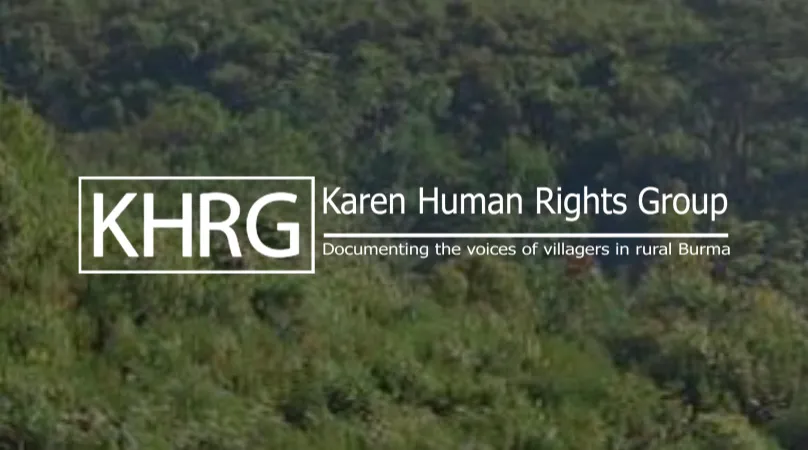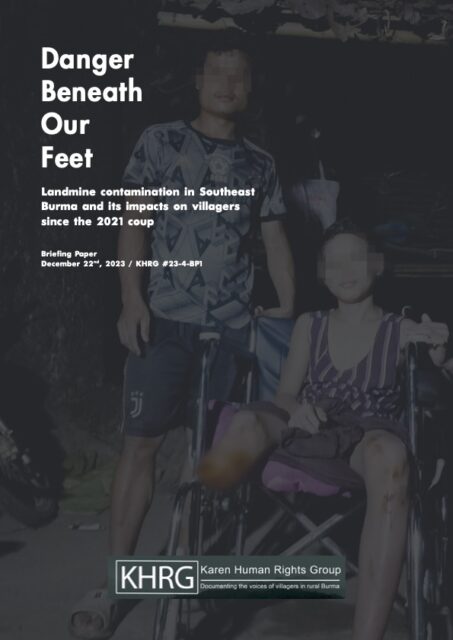Danger Beneath Our Feet – Landmine contamination in Southeast Burma and its impacts on villagers since the 2021 coup
22 December 2023


1. Introduction
Since the 2021 coup[2] and the subsequent intensification of armed conflict, the use of landmines has proliferated in Southeast Burma (Myanmar)[3]. Landmines are used by not only the State Administration Council (SAC)[4], but all armed actors in Southeast Burma, to both protect territory and attack opponents. Villagers are severely impacted by this proliferation and expansion of landmine use in the ongoing conflict and the SAC has been increasingly targeting civilians directly with these indiscriminate weapons. In locally-defined Karen State[5], this is causing civilian deaths and injuries and affecting the lives and livelihoods of villagers.
This briefing paper presents incidents of landmine explosions in civilian areas since the 2021 coup and examines the impacts and needs of the affected communities. The first section provides a brief overview of the context of landmine contamination in Southeast Burma. Secondly, evidence of landmine casualties and the impact on local communities, as well as the challenges and risks that villagers face, are presented. Thirdly, a security and legal analysis of the situation is conducted, as well as a set of policy recommendations provided for local and international stakeholders.
2. Contextual overview
Burma is the only country in the world where the ‘state security forces’ actively use landmines within its territory against their own civilian population[6]. Burma is not a party to the 1997 Mine Ban Treaty and it is listed as one of the 12 remaining landmine producers by the International Campaign to Ban Landmines (ICBL)[7]. According to the United Nations’ Myanmar Information Management Unit, all states and divisions, as defined by the Burma government, have been contaminated by landmines over the past decades.[8]
In the decades of conflict between the Burma Army[9] and armed resistance groups around the country, landmines have long been used to secure contested territory. However, the Burma Army has directly and actively targeted civilians with landmines as part of the “four cuts” strategy which aims to destroy links between insurgents, their families, and local villagers by cutting off food, funds, intelligence, and recruits to ethnic armed groups[10]. To prevent resistance forces from knowing where landmines are planted, the Burma Army has often deliberately withheld this information from civilians. Landmines remain in place from the decades of conflict, and the Burma Army is actively planting new landmines amid the intensified conflict as they seek to affirm nationwide military control following the 2021 coup. The current armed conflict has created immense difficulties preventing mine clearance programs from being implemented.
Karen State has a high level of landmine contamination[11]. Human rights abuses related to landmines are not a new issue; landmines and unexploded ordnance (UXOs) have posed a persistent threat to villagers throughout the decades of conflict.[12] With new landmines being extensively planted across Southeast Burma by both the SAC and armed resistance groups, there is now a combined danger of old and new landmines. These new landmines are being planted in areas unavoidable to villagers and they are increasingly not only accidental victims but are often targeted with landmines by the SAC and its affiliated armed groups.
According to Article 2.2 from the 1997 Mine Ban Treaty, a mine is defined as “a munition designed to be placed under, on or near the ground or other surface area and to be exploded by the presence, proximity or contact of a person or a vehicle.”[13] According to KHRG documentation, the SAC primarily uses factory-made mines whereas the Karen National Liberation Army (KNLA)[14], mostly use handmade mines, improvised explosive devices (IEDs) and anti-vehicle tripwire bombs.[15] KNLA handmade mines are not as powerful as SAC factory-made mines and, usually, factory-made can remain active for decades, whereas handmade mines usually have a lifespan of six months. Nonetheless, both pose a significant threat to local communities. The KNLA sometimes informs local villagers where soldiers plant landmines, but often not adequately. The SAC usually fails to inform local villagers where they plant landmines, or purposely conceals their location, presenting immense danger when this occurs in civilian areas.
3. Factual summary: Landmine incidents and impacts on local communities
This chapter presents incidents of anti-personnel landmine explosions and their impacts on local communities in Southeast Burma since the 2021 coup. Since February 2021, KHRG has received reports from across all seven KHRG operational districts[16] containing evidence of 64 landmine incidents involving villagers, which resulted in at least 21 deaths and 60 people injured, including children. These reports were collected by local community members trained by KHRG to document the human rights situation in Southeast Burma. Landmine incidents are often underreported because of security concerns preventing researchers from travelling to certain areas and victims/survivors lacking knowledge of how to report incidents. Therefore, the actual number of casualties resulting from landmine incidents is expected to be much higher.
Although both the SAC and armed resistance groups use landmines for military purposes −self-protection or territory defence− the main victims of landmine explosions are villagers as landmines are planted in villages, plantations and roads. From analysis of this information, some trends in landmine incidents in Karen State are explored: landmines are commonly stepped on when villagers are engaging in essential livelihood activities, landmines are harming villagers often in the aftermath of fighting between armed groups, and there is inadequate warning about landmine contamination. The impacts of landmine incidents are also presented, including coping with deaths and injuries, livestock being harmed, and restricted freedom of movement.
Announcements
28 February 2025
Asian NGO Network on National Human Rights Institutions , CSO Working Group on Independent National Human Rights Institution (Burma/Myanmar)
Open letter: Removal of the membership of the dis-accredited Myanmar National Human Rights Commission from the Southeast Asia National Human Rights Institution Forum

Progressive Voice is a participatory rights-based policy research and advocacy organization rooted in civil society, that maintains strong networks and relationships with grassroots organizations and community-based organizations throughout Myanmar. It acts as a bridge to the international community and international policymakers by amplifying voices from the ground, and advocating for a rights-based policy narrative.